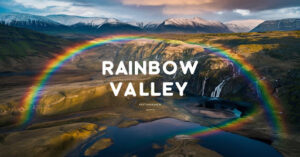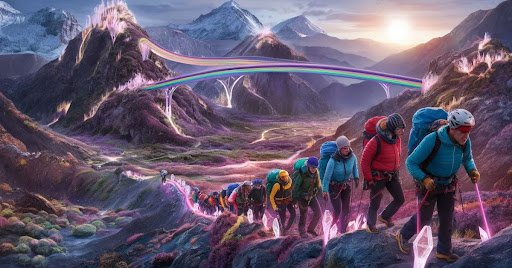Rainbow High Valley is poised high up on Mount Everest where climbers have left behind bright gears that speak to the beauty and danger of high-altitude conquests. It illustrates the mingling beauty of the highest mountain peak in the world and its potential dangers.
Rainbow High Valley Mount Everest is an evocative painting in which bright clothing between snowy peaks tells stories of bravery and selflessness Enter here, where all the colors are about success or tragedy, inspiring contemplation within these gigantic mountains Explore the dangerous yet beautiful aspect of mountaineering; its heart has been thumping unceasingly by man’s irrepressible struggle.
Discovering Rainbow High Valley– The Brightly Colored But Gloomy Slope of Everest is a place with steep rocks and climbers’ equipment on it, this is very moving in memory of the deaths and dangers that accompany mountain top investigations. Beautiful and sad at the same time in this area there are different objects like ropes strewn everywhere which seem to indicate human struggle against tough conditions inherent on influential slopes of these majestic mountains.
The Origins of the Name ‘Rainbow Valley’
Mount Everest’s treacherous terrain is a journey that attracts climbers who are known to have left an array of colorful equipment behind hence the name ‘Rainbow Valley’. When the mountain climbers climb up and down this mountain, they tend to forget gear and markers hence making other climbers see this place as a colorful Valley on the mountain full of ice and snow.
Amidst a devastated view lies skittishly erected tents and scanty oxygen tanks typifying pulse quickening sight. It’s a rainbow at Rainbow Valley Mt Everest in appreciation of courageous souls that have scaled the world’s tallest summit in this valley.
Geographical and Climatic Features of Rainbow Valley

Rainbow High Valley, formed by its high altitude and extreme climate, has some distinctive geographical features among others in the mountains of Mount Everest. It is one of the most difficult environments on earth because this beautiful place is situated at more than 8000 meters altitude with severe cold and strong winds ever thought about that?
The rocky outcrops, crevasses, and icy slopes of the valley form a majestic but perilous landscape for climbers.Its location on the Everest trail subjects it to sudden snowstorms and strong winds not to mention unpredictable weather patterns that further exacerbate potential danger associated with climbing this mountain.
Historical Context and Significance
The rich history of Rainbow Valley Mount Everest is closely connected with several mountain climbing expeditions and conquering. Everest climbing as a tough job has been admitted to by lots of superior climbers who have consequently gained or lost fame in this endeavor.
As much as Mount Everest is deemed the most popular peak on earth due to historic ventures like Sir Edmund Hillary and Tenzing Norgay’s triumphant climb in 1953, there still exist sorrowful incidents where mountaineers have perished along the ascent of Rainbow Valley hence giving it the same seriousness.
The Human Element: Stories from Rainbow Valley
The human element in Rainbow background Valley Mount Everest is poignant and profound, as it is ornamented with the relics of climbers’ journeys, each of which reflects individual stories of valor and selflessness. Through this colorful gear and memorials that are still present here today there are echoes of victories and failures which create a monument to the unassailable courage of explorers..
Personal stories shared by climbers who have climbed Mount Rainier offer insight into the physical and emotional difficulties experienced on this unforgiving terrain. These tales of hardships and friendship during hard times never fail to inspire awe and make one reflect on how strong our human spirits could be when up against forces of nature that seem overwhelming.
Challenges and Dangers of Climbing in the Death Zone
Oxygen deprivation: Due to the reduced levels of oxygen above 8,000 meters in the Death Zone, the thin air causes fatigue, dizziness, and impaired judgment.
Extreme weather:Negatively impactful are quick snow lots, scorching sun and falling temperatures, which heighten the probability of frostbite, hypothermia and avalanches.
Altitude sickness: Unconscious mountain climbers can fall at risk of altitude diseases such as pulmonary oedema and cerebral oedema, which can be fatal when they fail to get treatment.
Technical difficulties:Descending icy cliffs, navigating crevasses successfully is demanding and poses risks of falls and injuries..
Psychological stress:The decision-making and resilience of climbers can be affected by the mental strain obtained while enduring harsh conditions, witnessing accidents, and confronting mortality.
Future of Rainbow Valley and Mount Everest Climbing

In both Rainbow Valley and Mount Everest climbing, the future has lots of challenges and opportunities. Given that the face of Himalayas is changing due to global warming, there have been rising concerns regarding whether this mountainous region will remain stable since it is prone to avalanches and landslides more than before.
But, there is hope for safer, rainbow brite sustainable expeditions thanks to the current technological innovations as well as safety systems. Climbing can be made less dangerous and the environment impacted less if risk is controlled through enhanced weather predictions, advanced climbing gear, and more rigid laws.
Another development is that people are increasingly practicing sustainable mountain climbing that is ethical and responsibility-bound so as not to affect the. Integrity of Everest and the Ecosystems around it for the coming generations
Frequently Asked Question:
What is Rainbow Valley on Mount Everest?
Climbers have decorated Rainbow Valley with colorful accessories that depict the beauty and danger of being at a high altitude. Sadness permeates this place.
Why is Rainbow Valley called ‘somber’?
It is called somber because it reminds us of the dangers and sacrifices that climbers who took on Mount Everest went through.
What challenges do climbers face in Rainbow Valley?
Rock climbers face severe weather, altitude sickness, and technical problems in dealing with difficult terrain.
How can I explore Rainbow Valley safely?
For one to be able to safely explore Rainbow Valley, they need to enroll in a rigid training, employ professional guides, and strictly follow safety regulations.
What is the significance of Rainbow Valley in mountaineering history?
Rainbow Valley is significant in history for conveying to us about different things that took place in mountaineering on Mountain Everest since there were successful and unsuccessful climbing attempts on the same mountain that yearned to reach its peak amid other major mountains across the globe.
To sum up, the numerous inklings within “Exploring Rainbow Valley: The Colorful Yet Somber Side Of Mount Everest” renders out a mix of awe and danger that defines traveling at high altitudes. It witnesses stories of both victory and loss through the colorful artifacts left by the climbing team members, but shows that mankind is greater than what nature can impose.
As one thinks of the experiences that have been exchanged at Rainbow Valley, Mount Everest appears as not simply a mountain to be summit-ed but a symbol of human determination and ability to withstand mounting pressure or difficulties. Indeed, it causes us to meditate upon our linkages with Nature and deeply insightful knowledge gained when confronted with the highest mountains anywhere on this earth.
Also Read: Discover Rai Van: A Hidden Travel Gem



